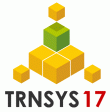TRNSYS
Quick Facts
TRNSYS is a simulation program primarily used in the fields of renewable energy engineering and building simulation for passive as well as active solar design. TRNSYS is a commercial software package developed at the University of Wisconsin. One of its original applications was to perform dynamic simulation of the behaviour of a solar hot water system for a typical meteorological year so that the long-term cost savings of such a system could be ascertained.
What is TRNSYS
TRNSYS is well suited to detailed analyses of any system whose behaviour is dependent on the passage of time. TRNSYS has become reference software for researchers and engineers around the world. Main applications include: solar systems (solar thermal and photovoltaic systems), low energy buildings and HVAC systems, renewable energy systems, cogeneration, fuel cells.
Due to its modular approach, TRNSYS is extremely flexible for modeling a variety of energy systems in differing levels of complexity. Supplied source code and documentation provide an easy method for users to modify or add components not in the standard library; extensive documentation on component routines, including explanation, background, typical uses and governing equations; supplied time step, starting and stopping times allowing choice of modeling periods. The TRNSYS program includes a graphical interface to drag-and-drop components for creating input files (Simulation Studio), a utility for easily creating a building input file (TRNBuild), and a program for building TRNSYS-based applications for distribution to non-users (TRNEdit). Web-based library of additional components and frequent downloadable updates are also available to users. Extensive libraries of non standard components for TRNSYS are available commercially from TRNSYS distributors. TRNSYS also interfaces with various other simulation packages such as COMIS, CONTAM, EES, Excel, FLUENT, GenOpt and MATLAB.
Using TRNSYS
The TRNSYS input file, including building input description, characteristics of system components, manner in which components are interconnected, and separate weather data (supplied with program) are all ASCII files. All input files can be generated with a graphical user interface known as Simulation Studio. The envelope for the TRNSYS building can now be three-dimensionally created in the TRNSYS3D plugin for Google SketchUp™ and edited in the TRNBuild interface.
Who Developed TRNSYS?
University of Wisconsin
How to get TRNSYS
Version 17, Commercial: $4500, Educational: $2250. Free demonstration version and information are available from technical contact. International distributors are located in Belgium, China, France, Germany, India, Japan, the Republic of Korea, Spain, Sweden, Tunisia, and the United States.
TRNSYS Outputs
Basic output format is ASCII. The data included in those files can be life cycle costs; monthly summaries; annual results; histograms; plotting of desired variables (by time unit). It is also possible toplot variables online (as the simulation progresses).
